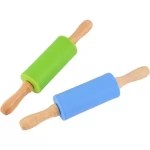Baking with kids is a fun and rewarding way to spend time together in the kitchen. From measuring and mixing to tasting the finished treat, time in the kitchen is the perfect place to create sweet memories and spark a lifelong love of baking.
Kitchen Safety & Skills for Young Bakers
Before you step into the kitchen, it’s important that young bakers learn basic kitchen and safety skills. Set clear expectations about what tasks need adult supervision—like using the oven or sharp tools—and which ones they can try on their own. You might consider using kid-safe nylon knives and teaching proper handwashing, how to measure ingredients properly, and how to safely handle hot pans for a safe and successful baking adventure.

Ingredients You’ll Need (and Why)
Baking is a hands-on way for kids to explore the “why” behind each ingredient. Young bakers can practice basic math while measuring and start to understand how different ingredients work together to create something delicious. Here’s a brief overview of a few common baking ingredients and why they’re used.
All-Purpose Flour – is the structure of any baked treat.
Sugar – adds sweetness and helps baked goods brown in the oven.
Eggs – bind everything together and help give baked goods shape and richness.
Butter or Oil – adds moisture and makes things soft and delicious.
Baking Powder/Baking Soda – helps treats rise and become fluffy.
Salt – balances sweetness and boosts all the other flavors.
Milk or Water – adds liquid to the batter or dough so everything mixes well.
Vanilla Extract – adds a warm flavor and makes the kitchen smell amazing.
Helpful Kid-Friendly Baking Tools
The right tools can make all the difference, especially when little hands are helping. While you might already have the basics covered, a few kid-friendly additions can make baking safer, easier, and more fun. Here are some handy tools to consider adding to your kitchen before the next baking session.
- Helpful Measuring Tools – color-coded measuring cups and spoons are easy for kids to find and use the correct measurements while liquid measuring cups with clear, easy-to-read markings make it easy to measure liquids and pour them out.
- Helpful Mixing Tools – plastic mixing bowls with rubber bottoms are lightweight and the rubber bottoms help to keep them from moving around on the counter. Using smaller sized baking utensils, like a silicone whisk, a silicone spatula and wooden spoon make it easier for smaller hands to hold and use when mixing or stirring ingredients and scraping the bowl.
- Helpful Baking Pans – a few basic pans to have on hand includes cookie sheets for cookies, an 8×8 pan is great for rice krispie treats, a 9×13 pan is perfect for cake or a large batch of brownies and a muffin tin for baking cupcakes or muffins.
- Other Helpful Items – kid-safe nylon knives are a perfect way for kids to safely learn knife skills, like chopping, while a cutting board will protect countertops. Smaller sized rolling pins are lighter and easier for smaller hands to use when rolling out dough. Plastic cookie cutters are a safer choice over metal ones and come in lots of shapes and sizes. Parchment paper or a silicone baking mat make for easier clean-up. And lastly, use kid-sized aprons to keep clothes clean and silicone oven mitts for handling hot items.
Tips for a Fun (and Stress-Free) Baking Day
A little preparation goes a long way toward creating a smooth and enjoyable kitchen experience. With the right setup (and some patience), even the messiest moments can turn into sweet memories. Here are a few simple tips to help keep things fun, stress-free, and full of smiles:
- Select the right tasks. Before you get into the kitchen to bake, determine what age-appropriate tasks your baker will perform and let them do that task with your supervision. Tasks like pouring, stirring and measuring ingredients work well for younger kids while older kids can take on more responsibility, like cracking eggs or reading baking steps aloud in the recipe.
- Read the recipe. Before beginning, read the entire recipe together. Not only will this explain what needs to be done without distractions, it also ensures you have all the ingredients and baking tools you’ll need before starting.
- Prep before you begin. Before you get started, clean your workspace, wash your hands, tie back long hair, and put on an apron. Then, gather your baking tools so everything is within easy reach.
- Get ingredients ready. Set out all of the ingredients that you’ll use, including anything that needs to come to room temperature. Once all the ingredients and tools are out, start measuring. Have multiple bowls out and measure all of your ingredients before you bake. Use one bowl for sugars, one for flour, etc. so that everything is pre-measured.
- Use baking as a learning opportunity. Baking is a fun and hands-on way to learn about math and science. Basic math skills and fractions can be taught when measuring ingredients and you can use science to explain why certain ingredients are used (for example, how baking powder helps things to rise when baking).
- Start with simple recipes. No-bake treats or muffins are a perfect recipe choice for beginners. Keeping it fun and manageable sets the stage for a positive, confidence-boosting experience that ends with a tasty treat.
Recipes Geared to Young Bakers
Whether you’re whipping up a batch of cookies or trying out a no-bake treat, be sure to check out our kid-friendly recipe collection and get inspired for your next baking day. Don’t forget to share your delicious creations!
Related
Discover more from From Scratch Baking
Subscribe to get the latest posts sent to your email.







